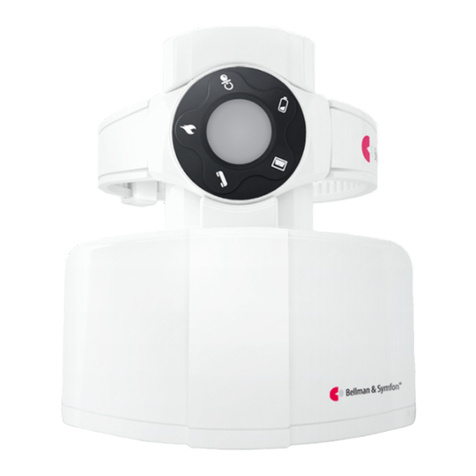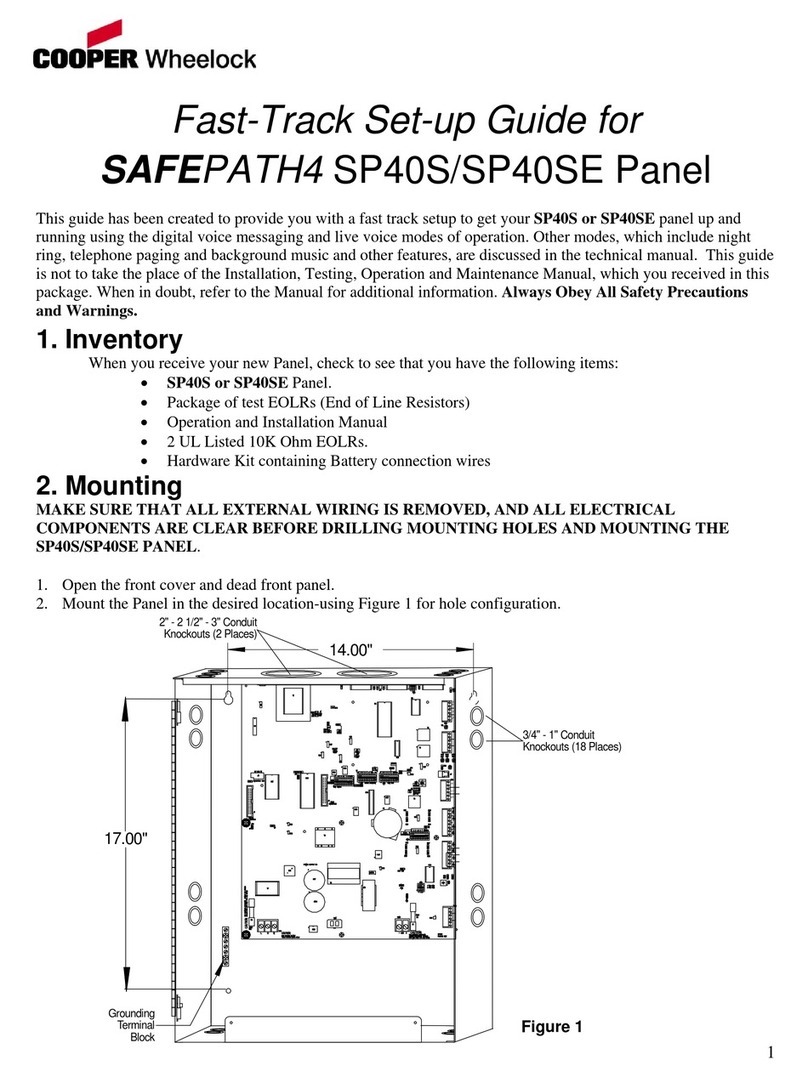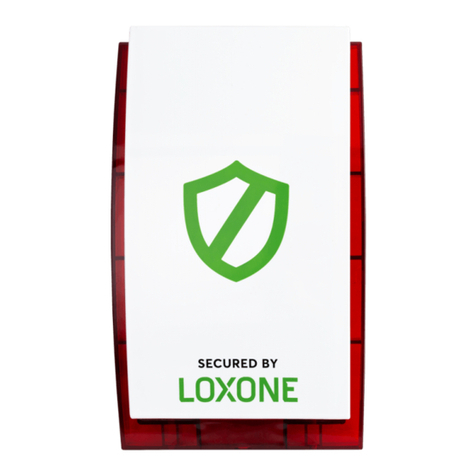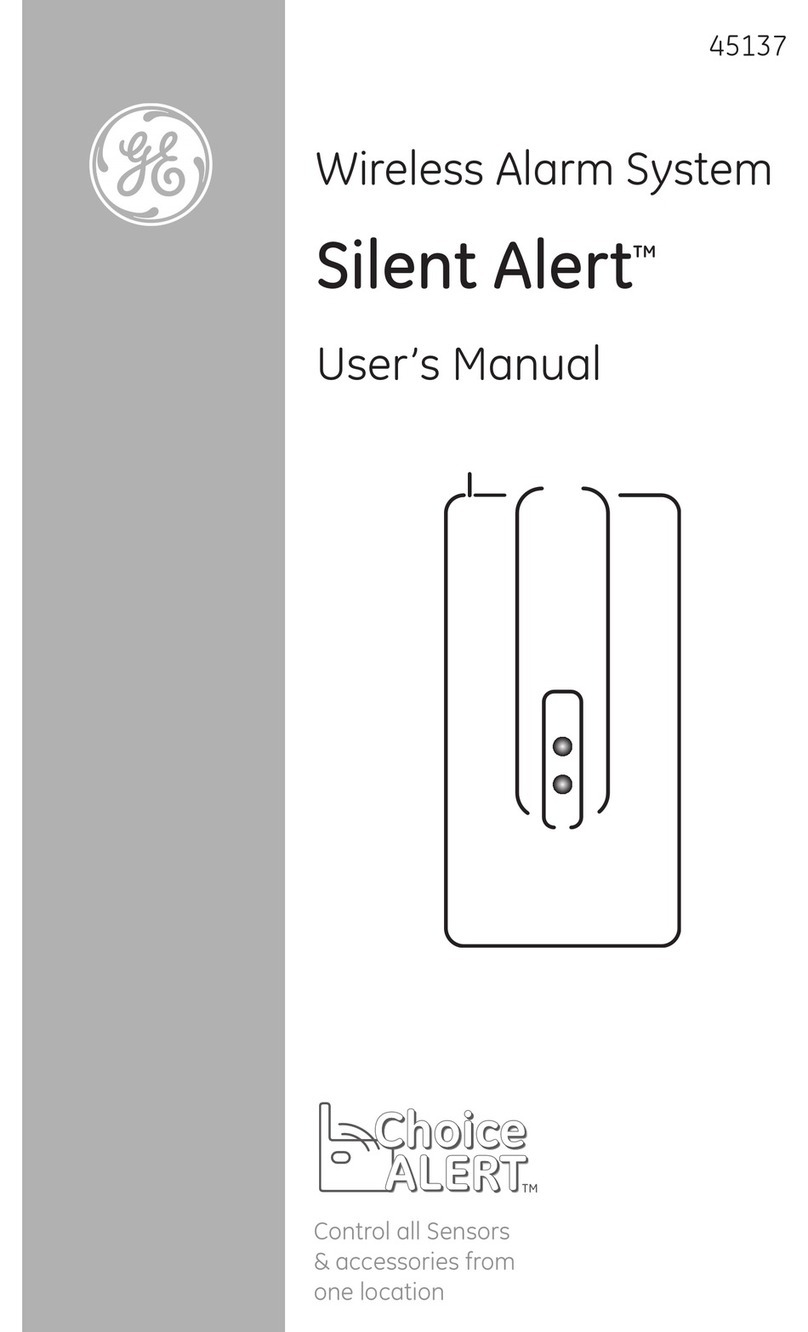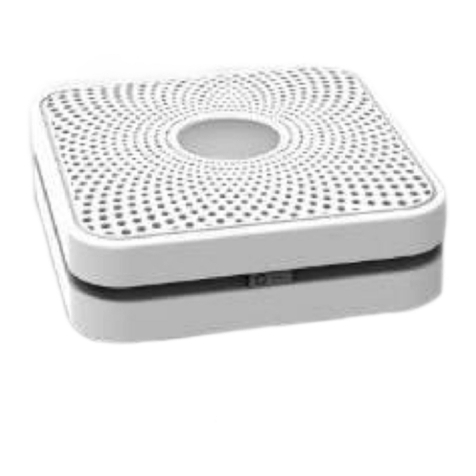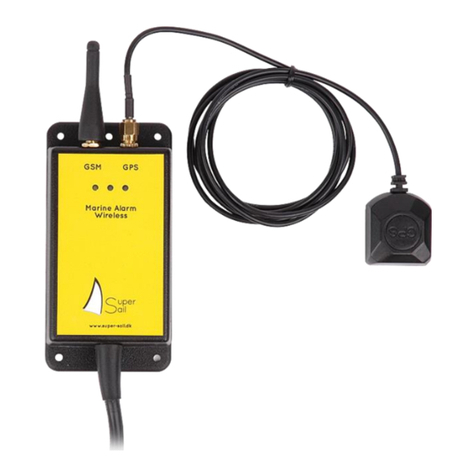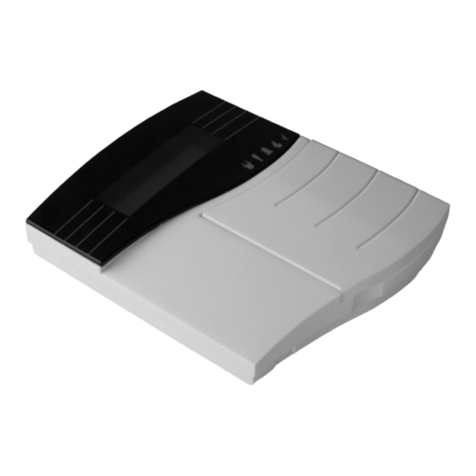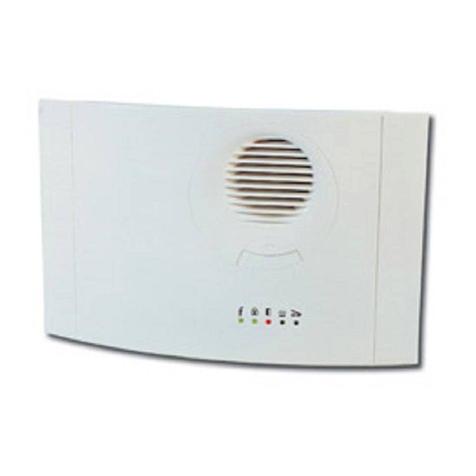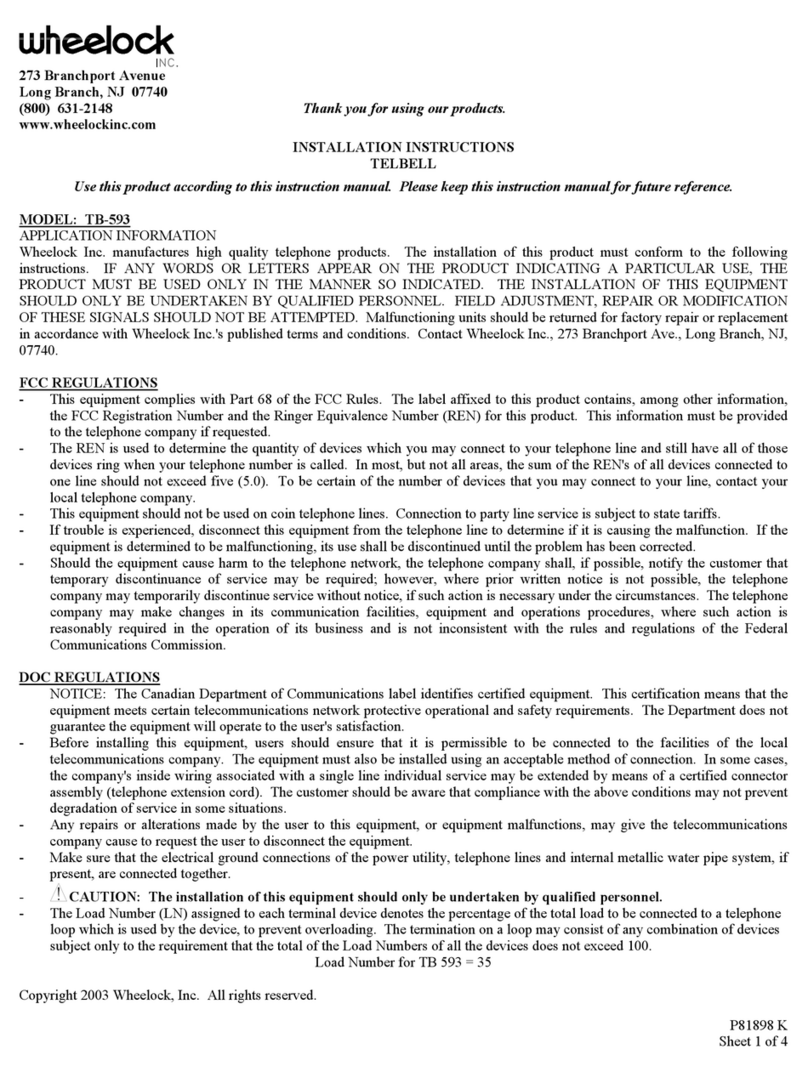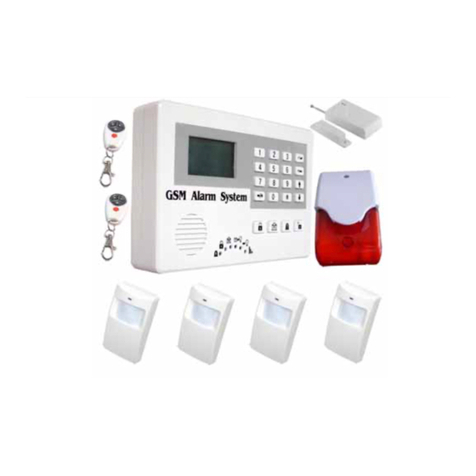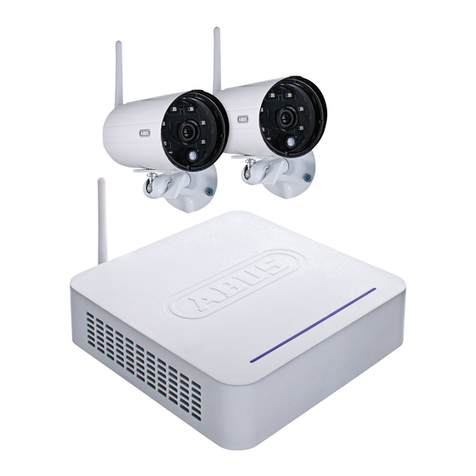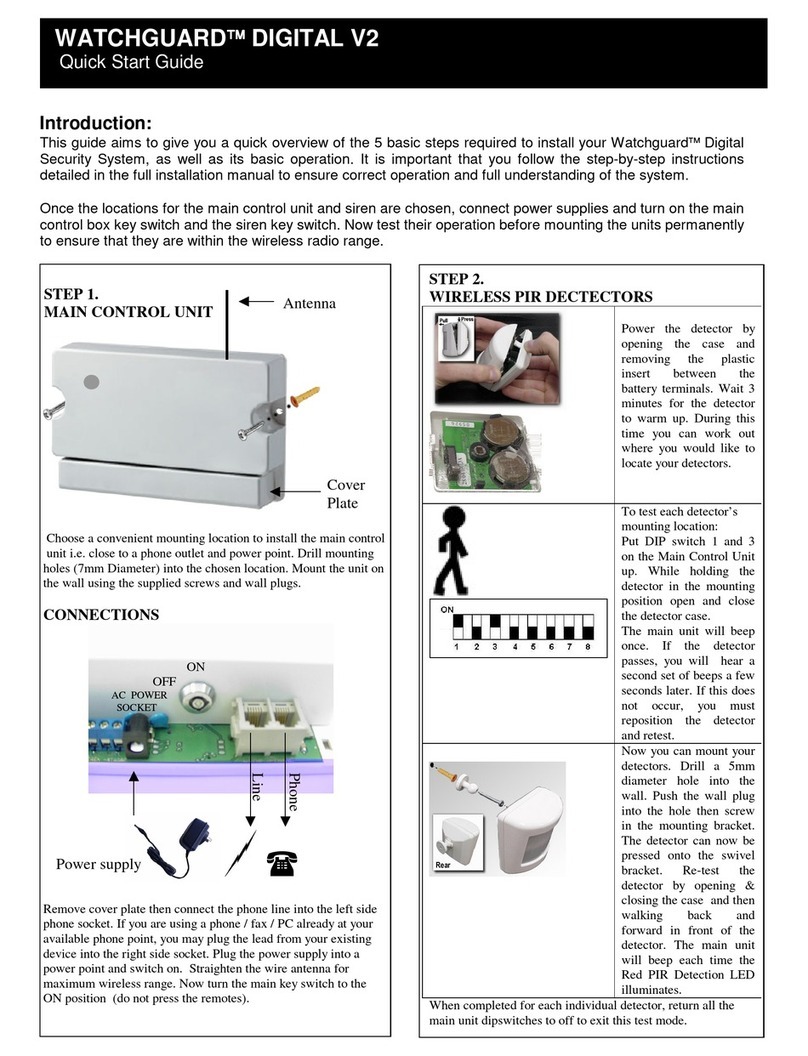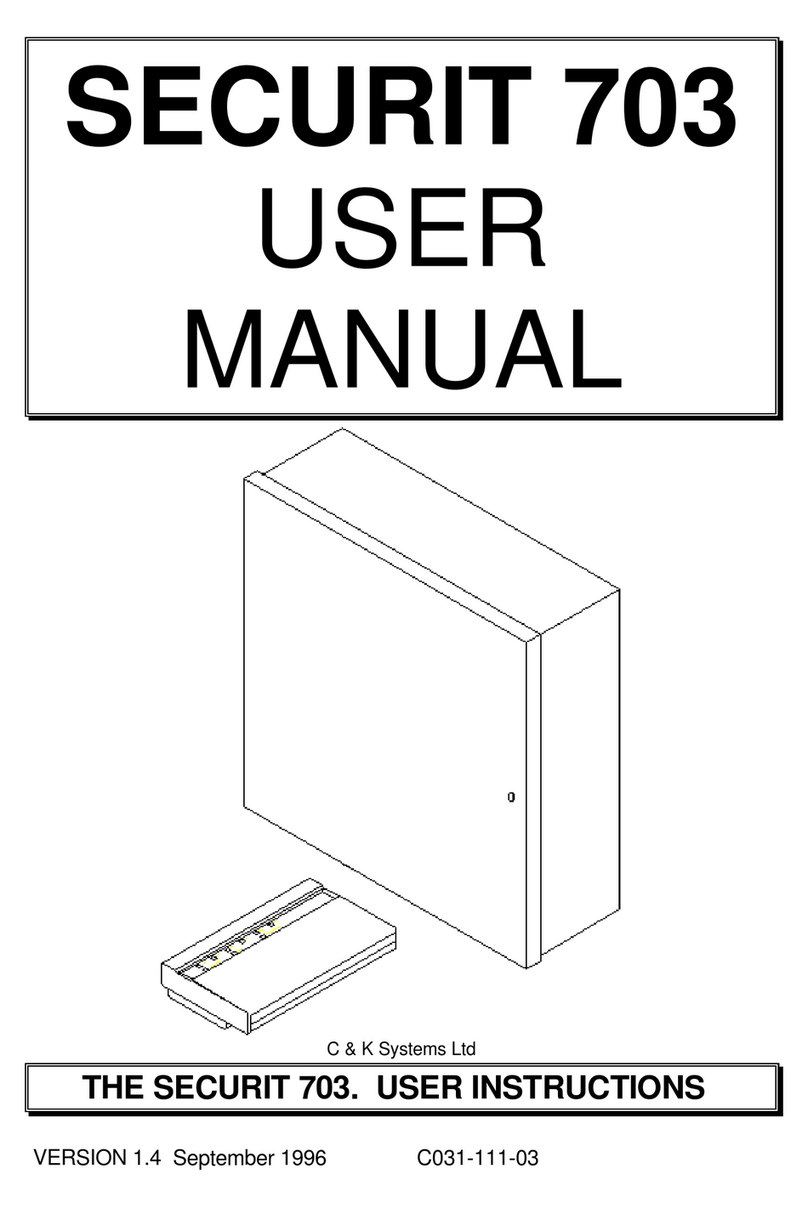Innohome Stove Guard 300 User manual

www.innohome.com
Safety for Your Kitchen
Stove Guard 300
User Manual

Stove Guard 300 User Manual

You now own one of the most intelligent
cooker safety products in the world.
Congratulaons!
Stove Guard 300 User Manual

4
Stove Guard 300 User Manual
1. Innohome Stove Guard and how to use it 1-6
1.1. Structure of the Stove Guard 1
1.2. Use of the Stove Guard 2-4
1.3. Automac fault diagnoscs 4
1.4. Meaning of alarm signals 5-6
2. Monthly Maintenance 6
3. Low baery alarm 6
4. Intelligent Heat Sensor Installaon 7
5. Control Unit Installaon and Setup 8
5.1. Installaon and setup 8
5.2. Connecng the Intelligent Heat Sensor to the Control Unit 8
6. Tesng aer Installaon 9
6.1. Alarm Signal Detecon test 9
6.2. Safety Lock test (if acvated during the installaon) 9
7. Checking the Control Unit sengs 9
8. Seng the sensivity level of the Intelligent Heat Sensor 10
9. Alarm output 11
10. Troubleshoong 11-12
11. Technical Informaon 13
12. Warranty 14
13. EU Declaraon of Conformity 14
CONTENTS

1
1.1 Structure of the Stove Guard
The Innohome Stove Guard is composed of an Intelligent Heat Sensor, a Control Unit, and oponal Remote Alarm Units.
The Intelligent Heat Sensor, the Control Unit and the Remote Alarm Units communicate via radio connecon. Using Remote
Alarm Units, addional signalling devices can be linked to the system.
The Intelligent Heat Sensor emits an alarm signal if the cooker becomes too hot or if an empty hob is le on. The alarm is
transmied to the Control Unit which cuts o the gas/electricity supply to the cooker. The alarm is also transmied to Re-
mote Alarm Units. See secon 1.2 for the Stove Guard’s other safety features.
The Intelligent Heat Sensor is aached to the range hood with magnets, on the wall (approximately 16” (40 cm) above the
cooker), or to the cooker panel.
The Control Unit is installed between the cooker and the mains electricity supply. For gas cookers, the Control Unit is plugged
into a socket near the gas cooker, and an electrical valve (available as an accessory), controlled by the Control Unit, is installed
in the gas supply. The Control Unit has an alarm output that can be used to alert a Telecare service or another homecare pro-
vider.
The Remote Alarm Unit TM13 (available separately) is an addional safety device that is especially useful for persons with
visual or hearing impairments and/or disabilies or memory disorders. It enables integrang alternave signalling devices
into the Stove Guard, such as ashing lights or vibrang alarms, and transming the alarm to rooms at a distance.
1. Innohome Stove Guard and how to use it
The push-buon (1) resets the alarm, reconnects
the gas/electricity to the cooker and turns o the
Safety Lock. The light (2) lights up at one-minute
intervals when the Intelligent Heat Sensor is on.

2
Stove Guard 300 User Manual
1.2 Use of the Stove Guard
Features depending on cooker type
a) Overheang Monitor
The Intelligent Heat Sensor detects temperature and its rate of change on the cooker surface (Overheang Monitor). The
Overheang Monitor alarm is triggered when the cooker temperature exceeds safe levels or when a rise in temperature is
faster than in normal cooking.
In a hazardous situaon, the alarm is triggered in 3 to 25 minutes. The Intelligent Heat Sensor rst emits a one-minute long
pre-alarm signal, which is followed by the alarm signal and the Control Unit cung o the cooker’s gas/electricity supply.
The alarm is reset by rst turning the cooker knobs to ‘0’, then pushing the Intelligent Heat Sensor push-buon once. Hot-
plates do not have to be turned o in cookers that are operated by touch. While the Intelligent Heat Sensor is new, the
sensivity level needs to adjust to the user’s cooker. This may result in alarms during normal cooking situaons at rst. If the
Intelligent Heat Sensor is signalling during a normal cooking situaon, reset the alarm during the pre-alarm signal by push-
ing the push-buon once. This will cancel the gas/electricity cut-
o and cause the Intelligent Heat Sensor to reduce its sensivity.
See table in secon 1.4 for descripon of the alarm signals.
Please note that the pre-alarm signal should be reset only if the
alarm was triggered by a normal cooking situation, as resetting
the pre-alarm signal results in the lessened sensivity of the
Intelligent Heat Sensor.
1. Innohome Stove Guard and how to use it
alarm
Electrical cooker; mechanical knobs Overheang Monitor
Intelligent Timer
Alarm Signal Detecon (re, carbon monoxide and gas alarms)
Cooker knob Safety Lock
Electrical cooker; operated by touch Overheang Monitor
Intelligent Timer
Alarm Signal Detecon (re, carbon monoxide and gas alarms)
Gas / dual-fuel cooker Overheang Monitor
Intelligent Timer
Alarm Signal Detecon (re, carbon monoxide and gas alarms)

3
1. Innohome Stove Guard and how to use it
The Overheang Monitor alarm also resets automacally in two minutes (approx.), when the gas/electricity to the cooker
has been cut o and the cooker temperature starts to fall (given that the oven is not in use). The automac alarm reset will
not aect the sensivity level of the Intelligent Heat Sensor.
Electrical cookers with mechanical knobs: Automac alarm reset turns o the alarm signal. Electricity is reconnected when
all hotplate knobs are turned to ‘0’.
Electrical cookers that are operated by touch: Automac alarm reset turns o the alarm signal and reconnects electricity to
the cooker (hotplates turned o aer the electricity cut-o).
Gas cookers: Automac alarm reset only aects the alarm signal. To reconnect the gas supply to the cooker; rst turn all
hobs to ‘0’, then press the Intelligent Heat Sensor push-buon once.
N.B. The Overheang Monitor alarm is not triggered if the hob’s temperature is too low for a hazardous situaon to be iden-
ed, or if the cooker automacally limits a temperature increase. When the alarm has been reset manually it cannot be
triggered by the rate of temperature change for 30 minutes, but can sll be triggered by the heat level. The Intelligent Heat
Sensor is an addional safety device that does not necessarily cover all possible hazardous situaons, but that signicantly
improves the safety of the cooker.
b) Intelligent Timer
The Intelligent Timer idenes when the cooker has been le on accidentally. The Timer starts automacally when a hob is
turned on. If the level of heat is not adjusted, as when cooking, the Stove Guard Control Unit cuts the gas/electricity supply
to the cooker. The cut-o me is determined by the amount of energy used by the hotplates: the higher the seng the
faster the gas/electricity supply to the hob is cut o. The cut-o me varies from half an hour to three hours. The Intelligent
Timer is designed to react only in hazardous situaons. The gas/electricity will not be cut o during cooking, even when the
cooker is used for an extended period of me.
The Control Unit will emit a pre-alarm signal for one minute before the Intelligent Timer cuts o the cooker’s gas/electricity
supply. The pre-alarm signal is reset by pressing the Intelligent Heat Sensor push-buon once. If it is not reset, the Control
Unit will cut the gas/electricity supply to the cooker and start to emit a signal. To reconnect the gas/electricity supply, rst
turn o the cooker hobs and then restore gas/electricity supply by pressing the Intelligent Heat Sensor push-buon once.
See table in secon 1.4 for descripon of the alarm signals.
Note: For some cookers that are operated by touch, the Intelligent Timer will not start when a hotplate is on a low seng.
This is because these cookers have a high standby energy consumpon rate. In some cookers, the Intelligent Timer only dis-
connects the electricity supply to the hobs, not to the oven.
c) Alarm Signal Detecon (re, carbon monoxide and gas alarms)
When the Stove Guard Control Unit detects an alarm signal from an addional re, carbon monoxide or gas alarm, the
Control Unit cuts the gas/electricity supply to the cooker. The Control Unit is factory set to idenfy most re/CO/gas alarm
signals. When the gas/electricity is cut o due to Alarm Signal Detecon, the Control Unit starts to emit a short signal. Re-
connect the gas/electricity supply by pressing the Intelligent Heat Sensor push-buon once. The Alarm Signal Detecon can

4
Stove Guard 300 User Manual
be deacvated using the jumper on the Intelligent Heat Sensor (see secon 4 ‘Opons’). All re/CO/gas alarms should be
located within 16.5 (5 metres) of the Control Unit to ensure accurate detecon. See table in secon 1.4 for descripon of
the Stove Guard signals.
d) Cooker knob Safety Lock
The cooker knob Safety Lock can only be used on electrical cookers with mechanical knobs. The Safety Lock makes sure that
the hotplates are not turned on accidentally. This greatly reduces the likelihood of hazardous situaons caused by children,
persons with disabilies or memory disorders, or pets. When the Safety Lock feature is in use, the electricity supply to the
hotplates is cut o approximately 20 minutes aer stopping using the hotplates. The electricity is reconnected by pushing
the Intelligent Heat Sensor push-buon once or by turning one of the cooker knobs on and o three mes at one second
intervals (turn on, turn o - wait 1 sec. - turn on, turn o - wait 1 sec. - turn on, turn o). The Control Unit will emit two
short beeps as the electricity is reconnected. The Safety Lock feature is acvated and deacvated during the Control Unit
setup (see secon 5).
1.3 Automac fault diagnoscs
For electrical cookers: The Stove Guard has an automac diagnosis funcon that ensures that the Stove Guard is working
perfectly each me a hotplate is turned on. The diagnosc tool analyzes the funcon of the Intelligent Heat Sensor, the
sensor electronics, the Control Unit, and the radio communicaon link between the Intelligent Heat Sensor and the Control
Unit. If any part of the system is not funconing, the Control Unit emits a fault signal, and aer a minute’s me, the cooker’s
electricity is cut o. The electricity cut-o can be prevented by reseng the fault signal during the rst minute by pressing
the Intelligent Heat Sensor push-buon once. See table in secon 1.4 for descripon of the alarm signals.
If the electricity supply has been cut o due to fault diagnosis, it can be restored by pressing the Intelligent Heat Sensor
push-buon once. If the fault diagnosis detects a problem, rst make sure that this is not due to a poor connecon between
the Intelligent Heat Sensor and the Control Unit: follow the instrucons in secon 5.2 about connecng the devices again. If
aer re-connecng the automac fault diagnoscs connues detecng a problem, contact the product retailer.
For gas/dual-fuel cookers: Refer to the gas kit manual.
1. Innohome Stove Guard and how to use it

5
1.4 Meaning of alarm signals
The Intelligent Heat Sensor signal has a higher tone than the Control Unit signal.
1. Innohome Stove Guard and how to use it
Sound Meaning Course of Acon
Intelligent Heat Sensor: a
short ‘beep’ every few sec-
onds
The Intelligent Heat Sensor has detected a
high temperature or a fast temperature rise
on the cooker surface (Overheating Moni-
tor). This is a pre-alarm signal that starts one
minute before the actual alarm. Reseng the
pre-alarm signal cancels the gas/electricity
cut-o and reduces Intelligent Heat Sensor’s
sensitivity. The pre-alarm signal should be
reset only if the alarm was falsely triggered by
a normal cooking situaon.
Reset the pre-alarm signal by pushing the
push-buon once.
Intelligent Heat Sensor:
repetitive fast ‘beep, beep,
beep’
The Intelligent Heat Sensor has detected a
high temperature or a fast temperature rise
on the cooker surface (Overheang Monitor,
alarm signal). The gas/electricity has been cut
o.
First turn o the cooker hobs (mechanical
knobs only), then reset the alarm signal by
pushing the push-buon once.
Control Unit: a short ‘beep’
every few seconds
This is the Intelligent Timer’s pre-alarm signal
that is given one minute before the Intelligent
Timer cuts off the cooker’s gas/electricity
supply. Reseng the pre-alarm signal cancels
the gas/electricity cut-o.
Reset the pre-alarm signal by pressing the
push-buon once.
Control Unit: a short signal
at approximately 5 second
intervals
The gas/electricity has been cut o either due
to the Intelligent Timer function, detection
of an external alarm signal, or the Intelligent
Heat Sensor detecng a high temperature or
a fast temperature rise.
First turn o the cooker hobs (mechanical
knobs only), then reset the alarm signal by
pushing the push-buon once.
Control Unit: a short signal,
followed by a long signal
(‘be-beep’), at approximate-
ly 5 second intervals
The gas/electricity is cut o due to the auto-
mac fault diagnosis detecng an error in the
Intelligent Heat Sensor’s connection to the
Control Unit or in the funconing of a part of
the system.
First turn o the cooker hobs (mechanical
knobs only), then reset the alarm signal by
pushing the push-button once. Connect
the devices again, see section 5.2. If the
problem persists, contact the product re-
tailer.

6
Stove Guard 300 User Manual
Sound Meaning Course of Acon
Control Unit: two short
beeps (after turning the
Safety Lock o)
The Safety Lock has been turned o and the
electricity reconnected to the cooker.
The cooker can now be used.
Control Unit: a signal every
hour or half hour
There has been an error in the idencaon
of the cooker.
Repeat the setup procedure as described
in secon 10 under the heading ‘the Con-
trol Unit signals every hour or half hour’.
Intelligent Heat Sensor (and
the Control Unit): a signal
once a minute
The Intelligent Heat Sensor has a low baery. Replace the baery, see secon 3. Pushing
the push-button on the Intelligent Heat
Sensor once will delay the battery alarm
for 12 hours.
A low baery in the Intelligent Heat Sensor causes both the Intelligent Heat Sensor and the Control Unit to emit a signal
once a minute. The baery alarm can be postponed for 12 hours by pushing the Intelligent Heat Sensor push-buon once.
The Control Unit will carry on eming the baery alarm signal aer the Intelligent Heat Sensor baery has been changed
(or aer it has run out). Reset the Control Unit baery signal by turning the cooker electricity o and then back on using the
cooker switch/the main switch. In gas cookers, turn the power of the Control Unit o, using the main switch or the socket
switch. Empty baery in the Intelligent Heat Sensor does not eect the safety features of the Control Unit.
Unscrewing the screw on the boom of the Sensor (2) (see picture in secon 4) opens the cover for changing the baery.
Use CR2032 type baeries.
3. Low baery alarm
2. Monthly Maintenance
Electrical cookers: Since the automac fault diagnoscs tests various parts of the Stove Guard every me a hotplate is
turned on, only the Alarm Signal Detecon feature needs to be tested on a monthly basis. For the Alarm Signal Detecon
test, refer to the secon 6.1.
Gas/dual-fuel cookers: Refer to the gas kit manual.
Clean the Intelligent Heat Sensor by wiping it with a cloth dampened with a mixture of household detergent and water.
Only use a cloth that does not leave bres.
Ensure that the baeries are good for all other alarms being used with your Innohome Stove Guard and that the alarms are
cleaned according to their instrucons.
1. Innohome Stove Guard and how to use it

7
1. Remove the Intelligent Heat Sensor from its packaging and allow it to reach room temperature, waing around 15 min-
utes.
2. Remove the protecve plasc strip from the Intelligent Heat Sensor. The Sensor will emit a signal when the power is con-
nected. Inialize the Intelligent Heat Sensor by pressing push-buon once.
3. Aach the Intelligent Heat Sensor to the range hood with magnets, as
close to the central point of the cooker as possible, but not too close to
the lights. Alternavely, the Intelligent Heat Sensor can be aached using
screws (remove the magnets rst by opening the cover and pushing them
out with a screwdriver) or adhesive tape (1). If using adhesive tape, rst
make sure that the surface is cleaned and dry. If the cooker has no range
hood, the Intelligent Heat Sensor can be attached to the wall, approxi-
mately 16” (40 cm) above the cooker, or to the cooker panel.
4. The sensivity level is factory set to suit most installaons. If this level is
unsuitable for your cooker and results in false alarms, reseng the alarm
during the pre-alarm signal will reduce the Intelligent Heat Sensor’s sensi-
vity. However, if the Intelligent Heat Sensor is installed higher than 25.5’’
(65 cm), or if the sensitivity level needs to be pre-set to a certain level
(when used in supported housing, for example), set the sensivity level manually (secon 8).
The screw (2) on the boom of the Intelligent Heat Sensor opens the cover for changing the baery.
Opons:
Oponal features are turned on/o using jumpers (3, picture above). A jumper is a small piece of plasc (a type of a short
conductor) that can be removed or changed to another posion.
Silent alarm: Remove the jumper (5) from the 4-5 posion.
Deacvaon of the Alarm Signal Detecon: Change the jumper (4) from the posion 2-3
to the posion 1-2.
Establishing communicaon with the Remote Alarm Unit TM13
The communicaon link between the Intelligent Heat Sensor and the Remote Alarm Unit starts automacally. However, if
you already have devices that use X10 transmission, or if the Remote Alarm Unit responds to your neighbour’s Intelligent
Heat Sensor, the house address of the Remote Alarm Unit must be changed manually (see the Remote Alarm Unit user man-
ual).
3
6
4
5
2 1
1
3
2
4. Intelligent Heat Sensor Installaon

8
Stove Guard 300 User Manual
5.1 Installaon and setup
If the cooker is connected to the mains electricity via a plug and a socket, the Control Unit can be installed by the user.
Otherwise, the installaon needs to be carried out by a qualied electrician.
Turn the electricity o at the main switch. Aach the Control Unit to the wall using screws, near the electricity outlet.
Installaon by user: connect the Control Unit between the cooker’s plug and the socket.
Installaon by an electrician: connect the Control Unit to the cooker using an Innohome Juncon Box or an Innohome Con-
necon Cable.
Turn the electricity back on at the main switch. The connecon between the Intelligent Heat Sensor and the
Control Unit will start automacally. Wait for 30 seconds and then carry out the setup procedure described
below. Cookers that are operated by touch will not require a setup procedure and the Stove Guard is ready
to use from the outset.
Setup procedure
Start the setup procedure by pressing the Control Unit setup buon (1, see picture on the right)
unl you hear a signal, then release the buon and press it again unl you hear a signal.
Now carry out the Safety Lock acvaon/deacvaon as follows:
• A gas cooker: No further procedure is needed. Wait unl you hear a signal to signify the end of the setup me.
• An electrical cooker with mechanical knobs:
Safety Lock funcon in use: Turn any of the hotplates on for 5 seconds, then turn it o. Wait unl you hear a signal to signi-
fy the end of setup me.
Safety Lock funcon not in use: Turn a hotplate on, wait unl you hear a beep from the Control Unit, then turn it o.
5.2 Connecng the Intelligent Heat Sensor to the Control Unit
This procedure is only needed if a) the automac fault diagnosis has detected a problem in the connecon between the
Intelligent Heat Sensor and the Control Unit or b) the Intelligent Heat Sensor’s baery has been replaced.
First carry out the setup procedure as described above (see ‘Setup procedure’), then proceed to the connecon procedure
described below. In cookers that are operated by touch follow the instrucons as for a gas cooker.
Connecon procedure
Press the Intelligent Heat Sensor push-buon (1, see picture in secon 4) unl you hear a signal from both the Intelligent
Heat Sensor and the Control Unit. Then the Intelligent Heat Sensor will emit an alarm signal and the Control Unit will cut the
gas/electricity supply to the cooker. Restore the gas/electricity supply by pressing the Intelligent Heat Sensor push-buon
once.
5. Control Unit Installaon and Setup
main switch

9
BEEP - 20 seconds break - BEEP - BEEP A cooker that is operated by touch
BEEP - BEEP - 20 seconds break - BEEP A cooker with mechanical knobs, Safety Lock acvated
BEEP - 20 seconds break - BEEP A cooker with mechanical knobs, Safety Lock deacvated
The Control Unit sengs can be checked by turning the power of the cooker o using the cooker switch/the main switch
and turning it back on aer 15 seconds. In gas cookers, turn the power of the Control Unit o, using the main switch or the
socket switch. The Control Unit will then emit signals to inform you about its sengs.
7. Checking the Control Unit sengs
6.1 Alarm Signal Detecon test
Turn the smallest hotplate to medium heat and test the re, carbon monoxide and gas alarms, one at a me. When detect-
ing an alarm signal the Control Unit will cut the gas/electricity supply to the cooker and emit a short signal at approximately
5 second intervals. Reconnect the gas/electricity by pushing the Intelligent Heat Sensor push-buon once.
6.2 Safety Lock test (if acvated during the installaon)
Make sure all the hotplates are turned o. The Safety Lock will acvate in 20 minutes and the electricity to the hotplates will
be switched o. Test the Safety Lock by trying to turn the hotplates on one by one.
Reset the Safety Lock by pushing the Intelligent Heat Sensor push-buon once or turn one of the cooker knobs on and o
three mes at one second intervals (turn on, turn o - wait 1 sec. - turn on, turn o - wait 1 sec. - turn on, turn o).
The Control Unit will emit two signals aer a short pause, indicang that the electricity has been reconnected.
6. Tesng aer Installaon

10
Stove Guard 300 User Manual
The sensivity level determines the level of heat or the rate of temperature change required to acvate the Intelligent Heat
Sensor.
The Intelligent Heat Sensor responds to the user reseng the Overheang Monitor pre-alarm signal (see secon 1.2) by
reducing its sensivity. However, if the Intelligent Heat Sensor is installed higher than 25.5’’ (65 cm), or if the sensivity level
needs to be pre-set to a certain level (when used in supported housing, for example), set the sensivity level manually. See
recommended sensivity level, depending on the installaon height, from the table below.
The grey area indicated in the table shows where in normal use, no manual seng of the sensivity level is required. The
level is indicated by the numbers 1 to 16, where 1 represents the most sensive level, and 16, the least sensive. The facto-
ry seng is 5.
Seng the sensivity level manually:
1. a) For a new Intelligent Heat Sensor: Remove the protecve plasc strip from the Intelligent Heat Sensor. In the fol-
lowing 20 seconds carry out the procedure described below in steps 2-5.
b) For an Intelligent Heat Sensor that has already been installed: Open the cover by unscrewing the screw on the
boom of the Sensor (2) (see picture in secon 4). Disconnect the Intelligent Heat Sensor baery; then reconnect it.
In the following 20 seconds carry out the procedure described below in steps 2-5. Aer compleng step 5 close the
Intelligent Heat Sensor cover by ghtening the screw on the boom of the Sensor.
2. Hold the Intelligent Heat Sensor push-buon for about 5 seconds, unl you hear a signal.
3. Release the push-buon and hold again unl the Intelligent Heat Sensor emits a signal.
4. Now press the push-buon as many mes as the level (1-16) you wish to set it to. Wait for the light to go o between
each press of the push-buon.
5. The Intelligent Heat Sensor will now emit twice as many signals as the level it is set to, in two lots: 2+2 signals for level 2,
3+3 signals for level 3, 4+4 signals for level 4, and so on.
cm
inch
level
120
--
--
--
8. Seng the sensivity level of the Intelligent Heat Sensor

11
The alarm output is a 3.5 mm stereo jack found on the Con-
trol Unit. The alarm output is a ‘normally open’ type (opto)
and it closes for one second when the Control Unit cuts the
gas or electricity supply.
If the alarm output does not work properly, change the po-
larity of the cable connecng to the alarm output.
OC1
CN1
Alarm
out NO
9. Alarm output
The Intelligent Heat Sensor alarm sounds in a non-hazardous situaon
• Aer the Intelligent Heat Sensor is installed, it needs to adjust to the kitchen environment, and ‘learn’ not to react in nor-
mal cooking situaons. If the Intelligent Heat Sensor starts to signal in a normal cooking situaon, reset the alarm during
the pre-alarm signal. This will cause the Intelligent Heat Sensor to reduce its sensivity.
The Intelligent Heat Sensor does not signal when it should
• Increase the Intelligent Heat Sensor’s sensivity (see ‘Seng the sensivity level of the Intelligent Heat Sensor’ secon 8).
• Test the alarm by pushing the Intelligent Heat Sensor push-buon unl you hear a warning tone. If the Intelligent Heat
Sensor neither emits a tone nor ashes its light, the baery may be at. To change the baery, open the case by unscrew-
ing the screw (2) (see picture in secon 4). Use CR2032 type baeries.
• If the Intelligent Heat Sensor sll does not work, contact the product retailer.
The Control Unit emits a short signal, followed by a long signal (‘be-beep’), at approximate-
ly 5 second intervals
• The automac fault diagnosis has detected a problem either in the connecon between the Intelligent Heat Sensor or in
the funconing of some part of the system. The electricity supply can be reconnected by pressing the Intelligent Heat Sen-
sor push-buon once.
• Re-connect the Intelligent Heat Sensor and the Control Unit, see secon 5.2.
• If the automac fault diagnosis carries on nding a problem, contact the product retailer.
The Control Unit signals every hour or half hour
• There has been an error in the idencaon of the cooker. Repeat the setup procedure in the following manner; 1) turn
the electricity o at the main switch, wait for 15 seconds, then turn it back on. 2) Wait for 5 seconds and turn it o again. 3)
Wait for 15 seconds and turn it on. The Control Unit will now emit a signal signifying that the setup has been completed.
In electrical cookers with mechanical knobs, you should then carry out the Safety Lock acvaon/deacvaon as de-
scribed in secon 5.1 under the heading ‘an electrical cooker with mechanical knobs’.
10. Troubleshoong

12
Stove Guard 300 User Manual
Frequency adjustment
• Occasionally, in some cookers that are operated by touch, this procedure will not resolve the problem. In this case, un-
plug the cooker from the Control Unit, keeping the Control Unit connected to the electricity outlet. Now carry out the
setup procedure described in secon 5.1, as for a gas cooker.
The Control Unit did not idenfy the alarm signal of the re/CO/gas alarm
• Clean the alarm with a vacuum cleaner.
• Change the baeries in the alarm if necessary.
• Check that the alarm is not located too far from the Control Unit. The alarms
should be located at a maximum distance of 16.5 (5 metres).
• Adjust the signal recognion frequency using the trimmer on the Control Unit (frequency adjustment, see the picture).
Turn the trimmer slowly between tests unl the Control Unit idenes the signal.
The Control Unit responds to other sounds e.g. a telephone ringing or noise from a televi-
sion
• Change the telephone’s ring tone or turn down the volume of the television. It is also possible to disable the Alarm Signal
Detecon feature, see secon 4 ‘Opons’.
The Safety Lock did not acvate within 20 minutes
• Check the seng of the Control Unit as advised in secon 7. If the Safety Lock was not acvated, redo the setup process
as described in secon 5.
The Intelligent Timer did not cut o the electricity supply in 3 hours
• Some cookers that are operated by touch have a high standby energy consumpon rate. In such cookers, the Intelligent
Timer will not start when a hotplate is on a low seng.
10. Troubleshoong

13
Cercaon: CE, Casing IP20
Patent FI 117526, FI 117878, PCT pending
Unit Connecon Power Cut-o me Features
SGC500 1-3 phase 240V AC
16 - 32A
1W
0,5 - 3 h (Intelligent Timer) Alarm Signal Detecon
Intelligent Timer
Safety Lock
Alarm output
Overheang and overload
protecon
Automac fault diagnosis
SA102RF Wireless
433MHz
10mW X10
(A1 NO),
Alarm 90 dB /
10 cm
Baery (10+ years
lifespan) or xed
power supply (5V)
3 - 25 min (Overheang
Monitor)
Intelligent Heat Sensor
Max sensing distance 1.2 m (3.9
)
Adjustable sensivity
Manual and automac
alarm reset
11. Technical Informaon

14
Stove Guard 300 User Manual
EN 60 730-1:2000 + A12:2003 + A1:2004 + A13:2004 + A14:2005 + A15:2007 + A16:2007, EN 60730-2-
1:1997+A11:2005, Direcves Low Voltage Direcve: 2006/95/EC EMC- direcve: 2004/108/EC.
Espoo 20111011
Technical Director Ma Myllymäki
13. EU Declaraon of Conformity
This product has a 24-month warranty that covers defects in material or workmanship, starng from
the date of purchase. The warranty does not cover any indirect damage caused by a malfunconing ap-
pliance, damage caused by negligence, or damage caused by failure to follow the instrucons properly.
12. Warranty


16
Stove Guard 300 User Manual
Stove Guard 300 User manual - 10.05.2013
Innohome Ltd
Tel: +358 9 4114 3359
Web: hp:// www.innohome.com
Metsänpojankuja 3
02130 Espoo
Finland
Safety for Your Kitchen
Table of contents
Other Innohome Security System manuals
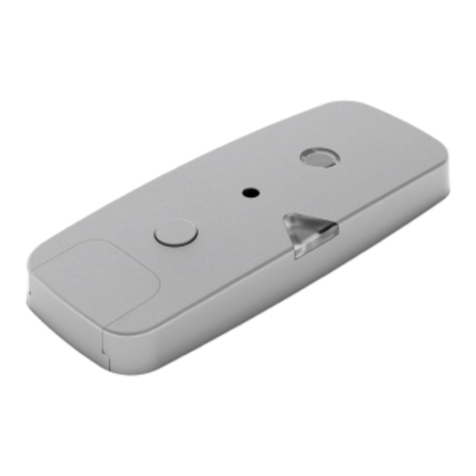
Innohome
Innohome SGS1030 User manual

Innohome
Innohome Stove Alarm SA100 User manual

Innohome
Innohome Stove Alarm SA101 User manual

Innohome
Innohome Smart Socket SSC100 User manual

Innohome
Innohome SGK510 Stove Guard User manual
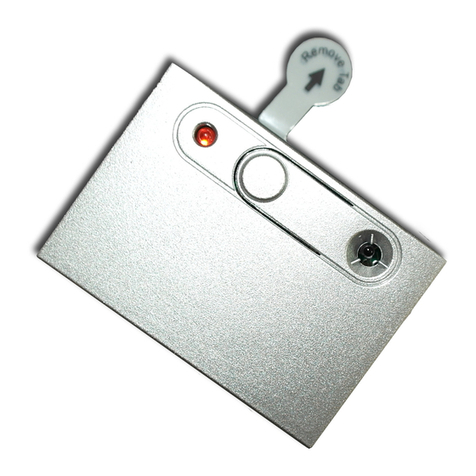
Innohome
Innohome SA102RF User manual

Innohome
Innohome Stove Alarm SA101 User manual


